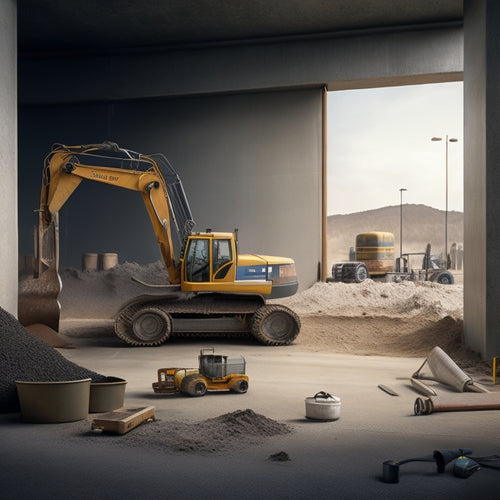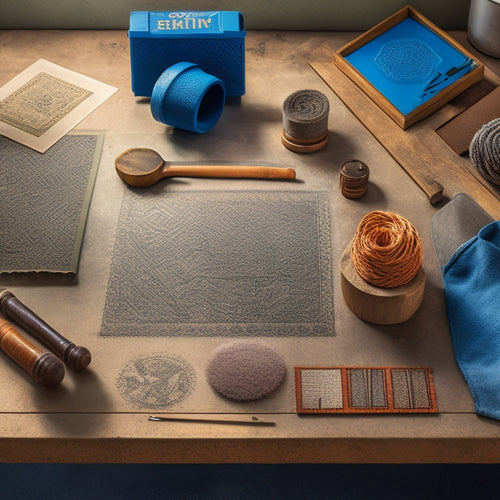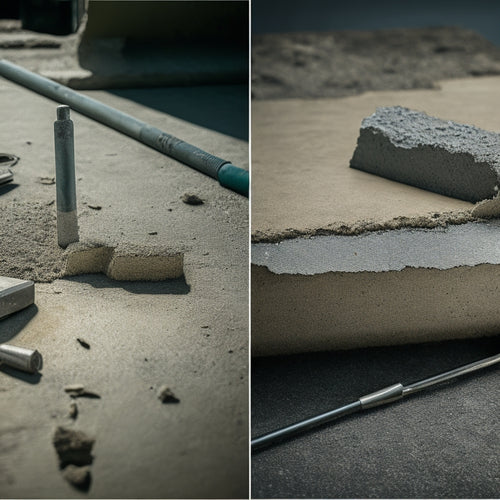
What Tools Do I Need for Concrete Work
Share
When tackling concrete work, you'll need a range of essential tools to get the job done safely and efficiently. Start with must-have safety gear like hard hats, safety glasses, and dust masks. Next, assemble a concrete tool checklist including trowels, floats, and edgers for mixing, pouring, and finishing tasks. Don't forget specialized equipment for mixing, like concrete mixers and mixing sticks, and for cutting, like demolition jackhammers and cutting saws. With the right tools, you'll be well-equipped to handle any concrete project - and learning about the specific uses and best practices for each tool will help you achieve professional-grade results.
Key Takeaways
• Essential safety gear includes hard hats, safety glasses, dust masks, gloves, and steel-toed boots to protect against hazards.
• Concrete tool checklist should include hand tools, finishing tools, measuring tools, cutting tools, and smoothing tools for various tasks.
• Mixing and pouring essentials involve concrete mixers, mixing tools, pouring equipment, and concrete pumps for efficient and accurate work.
• Finishing and smoothing tools like trowels, floats, edgers, and power trowels help achieve a smooth and even concrete surface.
• Demolition jackhammers, cutting saws, and specialized cutting techniques are required for breaking and cutting concrete safely and effectively.
Essential Safety Gear
When working with concrete, you must wear essential safety gear to protect yourself from the hazards associated with this physically demanding and potentially dangerous trade. Your personal protective equipment (PPE) is your last line of defense against injuries and illnesses. Make sure you have the right safety gear for the job.
Start with a hard hat to protect your head from falling objects and debris. Safety glasses or goggles will shield your eyes from flying particles and chemical splashes. A dust mask or respirator will prevent you from inhaling harmful dust and fumes.
Wear durable, puncture-resistant gloves to protect your hands from cuts, abrasions, and chemical exposure. Steel-toed boots with good traction will keep your feet safe from heavy objects and slippery surfaces.
Don't forget to wear long sleeves, long pants, and a dust-resistant jacket to prevent skin contact with concrete and its additives. Remember, safety gear isn't a one-size-fits-all solution. Choose equipment that fits comfortably and is appropriate for the specific tasks you'll be performing.
Concrete Tool Checklist
As you prepare for your concrete project, you'll need to gather the right tools to get the job done efficiently.
You'll want to make sure you have essential hand tools, like trowels and edgers, to handle mixing and pouring tasks.
Next, you'll need to assemble the tools required for finishing and smoothening, such as floats and finishing trowels, to achieve a professional-looking result.
Essential Hand Tools
Concrete work requires you to have a solid arsenal of essential hand tools that'll help you tackle various tasks efficiently and effectively.
These tools are vital for preparing, finishing, and repairing concrete surfaces. You'll need a tape measure, level, and square to guarantee accuracy and precision.
A hammer, utility knife, and wire cutters will come in handy for breaking, cutting, and shaping concrete.
Don't forget a putty knife, trowel, and edger for smoothing and finishing surfaces.
Mixing and Pouring
What tools do you need to guarantee a smooth mixing and pouring process that yields a strong, durable concrete finish?
To start, you'll need a concrete mixer, which can be a drum mixer or a tow-behind mixer, depending on the size of your project. You'll also need mixing tools like a mixing stick or a Jiffy mixer to assure a thorough mix.
When it comes to pouring, you'll need a pouring bucket or a chute to control the flow of concrete. For larger projects, consider investing in a concrete pump, which can considerably reduce labor and increase efficiency.
It's also essential to employ proper mixing techniques, such as mixing in a consistent pattern and scraping the sides of the mixer to prevent aggregation.
Similarly, pouring methods should be carefully planned to minimize segregation and assure a smooth, even finish. Consider using a pouring grid or a screed board to achieve a level surface.
Finishing and Smoothening
You'll need to switch gears and focus on the finishing and smoothening process, where the right tools can make all the difference in achieving a high-quality, defect-free concrete surface. This stage requires precision and attention to detail to achieve the desired surface texture.
To get the job done, you'll need the following tools:
| Tool | Description |
|---|---|
| Trowel | For applying and spreading concrete, and achieving smooth surfaces |
| Float | For flattening and leveling the concrete surface |
| Edger | For creating clean edges and joints |
| Broom | For creating textured surfaces |
| Power Trowel | For larger projects, to speed up the finishing process |
Mastering trowel techniques is essential in achieving the desired surface texture. From smooth and glossy to textured and broomed, the right tool and technique can make all the difference. Remember to always follow safety guidelines and wear protective gear when working with concrete. With the right tools and techniques, you'll be able to achieve a high-quality, defect-free concrete surface that meets your project's requirements.
Mixing and Pouring Essentials
With a solid understanding of your mix design, it's time to focus on the vital steps of mixing and pouring the concrete to achieve the desired consistency and finish.
When it comes to mixing techniques, you'll want to make sure you're using the right tools for the job. A concrete mixer or a mixing drum with a drill and mixing paddle is essential for thorough mixing. Always follow the manufacturer's instructions for mixing times and techniques to avoid over- or under-mixing.
Once your mix is ready, it's time to pour. Pouring methods can greatly impact the final result, so it's important to get it right. You'll need a pouring bucket or a concrete pump to transfer the mix to the desired location.
Make sure you're wearing protective gear, including gloves, safety glasses, and a dust mask, to minimize exposure to concrete dust and debris. When pouring, use a steady, consistent flow to avoid air pockets and make certain a smooth finish.
Remember to vibrate the concrete to remove any air bubbles and achieve the desired consistency.
Finishing and Smoothing Tools
Finishing and Smoothing Tools
After pouring the concrete, you're ready to start finishing and smoothing the surface, and that's where the right tools come in to help you achieve a professional-looking finish. To get the job done, you'll need a range of finishing and smoothing tools.
Here are some essential tools you'll need:
| Tool | Description | Purpose |
|---|---|---|
| Trowel | A flat, handheld tool with a curved or straight edge | Apply and smooth out concrete, creating various surface textures |
| Edger | A long, flat tool with a curved or angled edge | Create clean edges and joints, and remove excess concrete |
| Float | A flat, rectangular tool with a handle | Smooth and flatten the concrete surface, removing air pockets and imperfections |
Mastering trowel techniques is vital for achieving the desired surface texture. From smooth and flat to textured and decorative, the right techniques and tools can make all the difference. Remember to always follow safety guidelines and wear protective gear when working with concrete.
Cutting and Breaking Tools
When you're working with concrete, you'll inevitably need to cut or break it, and that's where cutting and breaking tools come in.
You'll want to make sure you're using the right tools for the job, and that you're using them safely - after all, cutting concrete can be hazardous if you don't take the right precautions.
In this section, we'll cover the essential tools you'll need, from demolition jackhammers to specialized cutting saws.
Cutting Concrete Safely
You'll need the right cutting and breaking tools to safely cut concrete, and choosing the correct ones depends on the type of cut you want to make and the concrete's strength and thickness.
When it comes to cutting concrete safely, you'll want to take into account the cutting techniques you'll be using. Will you be making a straight cut, a curved cut, or a plunge cut? Each technique requires a specific tool, such as a walk-behind saw, a handheld saw, or a diamond blade.
Before you start cutting, make certain you take the necessary safety precautions. Wear protective gear like gloves, safety glasses, and a dust mask to prevent injury from flying debris and concrete dust.
Confirm the area is well-ventilated and clear of obstacles. Use a hose to keep the concrete wet, reducing dust and preventing overheating of the blade.
Always follow the manufacturer's instructions for the specific tool you're using, and never use a tool that's damaged or worn out.
Demolition Jackhammers Needed
For heavy-duty demolition projects, a demolition jackhammer is an essential tool in your arsenal, providing the brute force needed to break up thick, reinforced concrete slabs and foundations.
When selecting a demolition jackhammer, take into account the type of project you're working on and the level of force required. There are various jackhammer types, including electric, pneumatic, and hydraulic, each with its own advantages and limitations.
Here are some key factors to take into account when choosing a demolition jackhammer:
-
Weight and maneuverability: Lighter jackhammers are ideal for smaller projects, while heavier ones provide more force for larger projects.
-
Power source: Electric jackhammers are suitable for indoor projects, while pneumatic and hydraulic ones are better suited for outdoor projects.
-
Bit type: Chisel bits are ideal for breaking up concrete, while spade bits are better for clay and soil.
-
Vibration control: Look for jackhammers with built-in vibration control to reduce operator fatigue and improve safety.
-
Safety features: Make sure your jackhammer has safety features such as a dead man's switch and a secure grip to prevent accidents.
Concrete Laying Accessories
Concrete laying accessories, such as bull floats and darbies, help you achieve a smooth, even surface by allowing for efficient screeding and leveling of freshly poured concrete. These tools are essential for mastering concrete texture techniques, which require precision and control.
You'll also need tamping tools, such as hand tampers or power tampers, to compact the concrete and remove air pockets.
When it comes to innovative curing methods, you'll want to take into account using concrete curing compounds or specialized curing blankets. These tools help maintain the ideal temperature and moisture levels necessary for proper concrete curing.
Additionally, you may need edging tools, like edging trowels or edging floats, to create clean, defined edges and joints.
By investing in these concrete laying accessories, you'll be well-equipped to produce high-quality, professional-looking results while ensuring a safe working environment.
Remember to always follow safety guidelines and best practices when working with concrete to avoid accidents and injuries.
Measuring and Testing Tools
Accurate measurements and testing are essential to guaranteeing the quality and strength of your concrete, which is where measuring and testing tools come into play. These tools help you verify that your concrete meets the required specifications, which is critical for safety and durability.
Here are some essential measuring and testing tools you'll need:
-
Tape measure: for measuring the length, width, and depth of your concrete pour
-
Slump test cone: for testing the workability and consistency of your concrete mix
-
Concrete thermometer: for measuring the temperature of your concrete, which affects its setting time and strength
-
Vibrating table or tamper: for removing air pockets and guaranteeing proper consolidation of your concrete
-
Concrete test hammer: for testing the surface hardness and density of your concrete
Cleaning and Maintenance Items
You'll need to keep your tools and equipment in top condition to guarantee consistent results, which is where cleaning and maintenance items come into play. Regular cleaning will prevent damage, promote accuracy, and prolong the lifespan of your tools.
Invest in a variety of cleaning solutions, such as degreasers, solvents, and rust removers, to tackle different types of dirt and grime. Don't forget to include soft-bristled brushes, scrubbers, and rags to help with the cleaning process.
Create a maintenance schedule to stay on track and prioritize tasks. Set aside time each week to inspect and clean your tools, paying attention to moving parts, electrical components, and areas prone to rust.
Regularly lubricate moving parts, and replace worn-out or damaged components promptly. Keep a record of your maintenance activities to track progress and identify areas for improvement.
Frequently Asked Questions
Can I Use a Regular Drill for Drilling Into Concrete?
You're wondering if you can use a regular drill for drilling into concrete? The answer is no, you shouldn't.
Regular drills aren't designed to handle the intense force and heat generated when drilling into concrete. Instead, you'll need a drill specifically designed for concrete work, like a hammer drill or rotary hammer, paired with concrete bits.
These tools are built to withstand the demands of concrete drilling, ensuring your safety and getting the job done efficiently.
Do I Need to Seal My Concrete After It's Cured?
Oh, you think you can just slap some concrete down and call it a day? Think again!
Sealing your concrete after it's cured is like wearing a helmet while riding a motorcycle - it's a no-brainer. You'll reap sealing benefits like protection from stains, cracks, and erosion.
There are various sealing techniques to choose from, including topical sealers, penetrating sealers, and integral sealers.
Don't risk your concrete's integrity; take the extra step and seal it up for a durable, long-lasting finish.
Can I Mix Concrete by Hand or Do I Need a Mixer?
When it comes to mixing concrete, you're wondering if you can do it by hand or need a mixer.
Hand mixing is possible, but it requires proper mixing techniques to avoid inconsistencies. You'll need to thoroughly combine the ingredients in a specific order, usually starting with dry materials and then adding water.
However, for larger batches or more complex projects, a mixer is recommended for efficiency and safety.
How Long Does It Take for Concrete to Fully Cure?
'Get down to business' and understand that concrete curing time varies greatly.
You'll need to wait anywhere from 24 hours to 28 days, depending on the environmental factors like temperature, humidity, and air circulation.
The curing process is a delicate dance, and you must be patient. Don't rush it, or you'll risk weakening the concrete.
Follow the manufacturer's instructions and keep the site clean, dry, and protected from extreme weather conditions to guarantee a strong, safe, and durable finish.
Can I Use a Regular Broom to Finish Concrete?
When you're finishing concrete, you'll need a specialized broom, not a regular one. A regular broom won't provide the right texture and can leave marks.
Instead, use a concrete broom or a stiff-bristled broom designed for finishing techniques. These brooms are made to handle the dense, wet concrete and will give you a smooth, even finish.
Always choose the right tool for the job to guarantee a safe and successful project.
Conclusion
You've got the right gear, and you're ready to tackle that concrete job. But remember, having the right tools is just half the battle.
Research suggests that 80% of concrete failures are due to poor workmanship, not material defects. So, don't just focus on the tools, focus on developing the skills and techniques to use them effectively.
With practice and patience, you'll be pouring like a pro in no time.
Related Posts
-

Why You Need Affordable Concrete Wall Construction Tools
You need affordable concrete wall construction tools to guarantee a profitable project, as the cost of equipment can ...
-

5 Best Tools for Stamping Concrete Walls
When it comes to stamping concrete walls, you'll need a range of specialized tools to achieve the desired texture and...
-

Top Tools for Concrete Adhesion Success
When it comes to concrete adhesion success, you'll need to wield the right tools and techniques to guarantee a strong...


